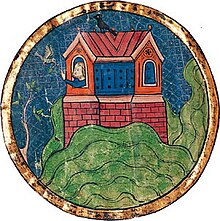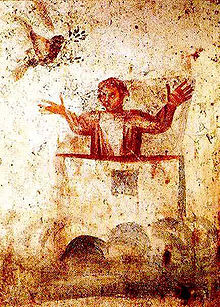http://en.wikipedia.org/wiki/Noah
Noah (or Noe, Noyach; Hebrew: נֹחַ, נוֹחַ, Modern Noaẖ Tiberian Nōăḥ; Arabic: نوح Nūḥ; Greek: Νωέ) was, according to the Hebrew Bible, the tenth and last of the antediluvian Patriarchs. The biblical story of Noah is contained in chapters 6–9 of the book of Genesis, where he saves his family and representatives of all animals from the flood by constructing an ark.[1] He is also mentioned as the "first husbandman" and in the story of the Curse of Ham. Noah is the subject of much elaboration in later Abrahamic traditions.
Noah was the son of Lamech who named him Noah, saying, "This same shall comfort us in our work and in the toil of our hands, which cometh from the ground which the LORD hath cursed."[2] In his five hundredth year Noah had three sons, Shem, Ham, and Japheth. In his six hundredth year God, saddened at the wickedness of mankind, sent a great deluge to destroy all life, but instructed Noah, a man "righteous in his generation," to build an ark and save a remnant of life from the Flood.
After the Flood, "Noah was the first tiller of the soil. He planted a vineyard; and he drank of the wine." Noah's son Ham saw his father naked in his father's tent, and told his brothers, and so Noah cursed Ham's son Canaan, giving his land to Shem.[3]
Noah died 350 years after the Flood, at the age of 950,[4] the last of the immensely long-lived antediluvian Patriarchs. The maximum human lifespan, as depicted by the Bible, diminishes rapidly thereafter, from as much as 900 years to the 120 years of Moses.
Jewish perspectives

A Jewish depiction of Noah
The righteousness of Noah is the subject of much discussion among the rabbis.[5] The description of Noah as "righteous in his generation" implied to some that his perfection was only relative: In his generation of wicked people, he could be considered righteous, but in the generation of a tzadik like Abraham, he would not be considered so righteous. They point out that Noah did not pray to God on behalf of those about to be destroyed, as Abraham prayed for the wicked of Sodom and Gomorrah. In fact, Noah is never seen to speak; he simply listens to God and acts on his orders. This led such commentators to offer the figure of Noah as "the man in a fur coat," who ensured his own comfort while ignoring his neighbour. Others, such as the medieval commentator Rashi, held on the contrary that the building of the Ark was stretched over 120 years, deliberately in order to give sinners time to repent. Rashi interprets his father's statement of the naming of Noah (in Hebrew נֹחַ) “This one will comfort (in Hebrew– yeNaHamainu יְנַחֲמֵנו) from our work and our hands sore from the land that the Lord had cursed”,[6] by saying Noah heralded a new era of prosperity, when there was easing (in Hebrew – nahah - נחה) from the curse from the time of Adam when the Earth produced thorns and thistles even where men sowed wheat and that Noah then introduced the plow.
Christian perspectives

An early Christian depiction showing Noah giving the gesture of
orant as the dove returns.
The Gospel of Luke, (Luke17:26), equates Noah's Flood with the coming Day of Judgement: “Just as it was in the days of Noah, so too it will be in the days of the coming of the Son of Man.” Noah is called a "preacher of righteousness" in 2 Peter 2:5, and the First Epistle of Peter equates the saving power of baptism with the Ark saving those who were in it. In later Christian thought, the Ark came to be equated with the Church: salvation was to be found only within Christ and his Lordship, as in Noah's time it had been found only within the Ark. St Augustine of Hippo (354-430), demonstrated in The City of God that the dimensions of the Ark corresponded to the dimensions of the human body, which corresponds to the body of Christ; the equation of Ark and Church is still found in the Anglican rite of baptism, which asks God, "who of thy great mercy didst save Noah," to receive into the Church the infant about to be baptised.
Noah's three sons were generally interpreted in medieval Christianity as the founders of the populations of the three known continents, Japheth/Europe, Shem/Asia, and Ham/Africa, although a rarer variation held that they represented the three classes of medieval society - the priests (Shem), the warriors (Japheth), and the peasants (Ham). In the 18th and 19th centuries the view that Ham's sons in general had been literally "blackened" by the curse of Noah was cited as justification for black slavery.
Contemporary academic perspectives
According to the documentary hypothesis, the first five books of the Bible ( Pentateuch / Torah ), including Genesis, were collated during the 5th century BC from four main sources, which themselves date from no earlier than the 10th century BC. Two of these, the Jahwist, composed in the 10th century BC, and the Priestly source, from the late 7th century BC, make up the chapters of Genesis which concern Noah. The attempt by the 5th century editor to accommodate two independent and sometimes conflicting sources accounts for the confusion over such matters as how many pairs of animals Noah took, and how long the flood lasted.
More broadly, Genesis seems to contain two accounts concerning Noah, the first making him the hero of the Flood, the second representing him as a husbandman who planted a vineyard. This has led some scholars to believe that Noah was believed by the ancients to be the inventor of wine, in keeping with the statement at Genesis 5:29 that Lamech "called his name Noah, saying, 'Out of the ground which the Lord has cursed this one shall bring us relief from our work and from the toil of our hands.'"[15]
Noah's great grandfather Enoch is the beginning of a web of similarities between the story of Noah and older Mesopotamian myths. According to Genesis 5:24, at the end of his 365 years Enoch "walked with God, and was not, for God took him" - the only of the ten pre-Flood Patriarchs not reported to have died. It is not explicitly stated where he is taken in Genesis. However, in Hebrews 11:5, it states that he did not die. Enoch and Elijah in 2Kings 2:1, are two people who experienced assumption (did not see death). In a late Apocryphal tradition, Methuselah is reported to have visited Enoch at the end of the Earth, where he dwelt with the angels, immortal. The details bring to mind Utnapishtim, a figure from the Mesopotamian Epic of Gilgamesh - the hero Gilgamesh, after long and arduous travel, finds Utnapishtim living in the paradise of Dilmun / Bahrain at the end of the Earth, where he has been granted eternal life by the gods. (Gilgamesh's reason for seeking out Utnapishtim, incidentally, is to learn the secret of immortality - like Methuselah, he comes close to the gift but fails to achieve it). Utnapishtim then tells how he survived a great flood, and how he was afterwards granted immortality by the gods. It has been suggested that the Flood story may originally have belonged to Enoch.[15]
Lamech's statement that Noah will be named "rest" because "out of the ground which the Lord has cursed this one shall bring us relief from our work and from the toil of our hands," has another faint parallel in Babylonian mythology: the gods grew tired of working, digging the channels of the rivers, and so the god Enki created man from clay and blood and spit to do the work for them. Enki fell in love with his creation, and later warned Utnapishtim that the other gods planned to send a flood to destroy all life, and advised him on how to construct his ark.
Noah is also often compared to Deucalion, the son of Prometheus and Pronoia in Greek mythology. Like Noah, Deucalion is a wine maker or wine seller; he is forewarned of the flood (this time by Zeus); he builds an ark and staffs it with creatures - and when he completes his voyage, gives thanks and takes advice from the gods on how to repopulate the Earth. Deucalion also sends a pigeon to find out about the situation of the world and the bird return with an olive branch. This and some other examples of apparent comparison between Greek myths and the "key characters" in the Old Testament/Torah have led recent Biblical scholars to suggest a Hellenistic influence in the composition of the earlier portions of the Hebrew Bible.[citation needed]